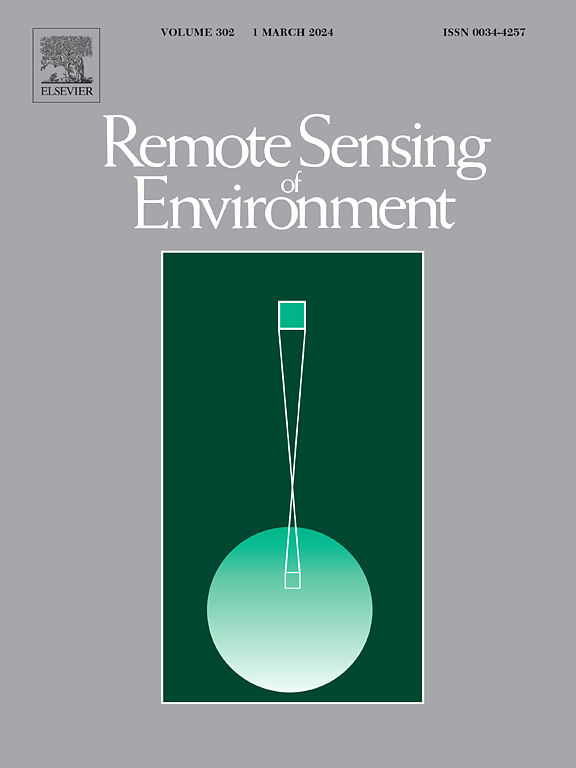Mapping of sea ice in 1975 and 1976 using the NIMBUS-6 Scanning Microwave Spectrometer (SCAMS)
IF 11.1
1区 地球科学
Q1 ENVIRONMENTAL SCIENCES
引用次数: 0
Abstract
The Scanning Microwave Spectrometer (SCAMS) onboard the NIMBUS-6 satellite operated between 15 June 1975 and 1 June 1976. Its primary mission objective was to map tropospheric temperature profiles for improving weather predictions, measuring Brightness Temperature(s) (s) at five different frequencies (22.235, 31.65, 52.85, 53.85 and 55.45 GHz). However, the top-of-the-atmosphere emission measured at the 22.235 and the 31.65 GHz radiometer channels on the satellite are dominated by surface emission over polar open water and sea ice and can therefore be used for mapping sea ice concentration (SIC) on large scale (100 km).
Here we present a SIC and ice type data set, which is based on the observations of the two lowest frequencies of SCAMS (center frequencies at 22.235 & 31.65 GHz). While the SCAMS channels do not completely align with the usual frequencies for sea ice retrievals (19, 22 and 37 GHz) in modern processing methods, it is still possible to apply modern techniques to reduce noise in the data. The SIC dataset provides important insights into the sea ice concentration, extent and type of the mid 1970s, where other satellite datasets e.g. the NIMBUS-5 ESMR have gaps and irregular coverage. The SCAMS data has been processed following modern methods, including a regional noise reduction over open water using a simple radiative transfer model, land-spillover corrections and estimation of uncertainties, as well as dynamical tie-points to calibrate the algorithm. The data set has been resampled into daily files with EUMETSAT’s OSI-SAF and ESA CCI compatible daily grids and land masks, for easier comparison with other data sets, such as the modern multi-frequency period starting with NIMBUS-7 SMMR in October 1978 to present and the 1972–1977 period covered by the NIMBUS-5 ESMR with some interruptions. The SCAMS s were processed with a hybrid SIC algorithm, combining a one and a two-channel algorithm over open water and ice respectively.
We find that the SIC calculated by the two-channel algorithm has more noise over water and low SIC areas than the single-channel algorithm. However, the two-channel algorithm does not systematically underestimate SIC in regions covered by Multi Year Ice (MYI) as the single channel algorithm does. A classification of sea ice types for First Year Ice (FYI) and MYI in the Northern Hemisphere (NH) proved successful, while it was also possible to identify two surface types A and B for the Southern Hemisphere (SH) sea ice, with different radiometric signatures.
A comparison of monthly mean sea ice extent (SIE) with the NIMBUS-5 ESMR showed good alignment in the both hemispheres, where the SCAMS SIE is larger by 386 676 km and 251 304 km on average in the NH and SH, respectively. SCAMS fills a gap in the N5ESMR record including the Arctic SIE minimum and the Antarctic maximum in 1975.
利用NIMBUS-6扫描微波光谱仪(SCAMS)绘制1975年和1976年海冰图
NIMBUS-6卫星上的扫描微波光谱仪(SCAMS)在1975年6月15日和1976年6月1日之间工作。它的主要任务目标是绘制对流层温度分布图,以改进天气预报,测量五个不同频率(22.235、31.65、52.85、53.85和55.45 GHz)的亮度温度(TBs)。然而,在卫星上22.235 GHz和31.65 GHz辐射计信道上测量到的大气顶发射主要是极地开阔水域和海冰上的地表发射,因此可以用于大尺度(~ 100公里)的海冰浓度(SIC)制图。在这里,我们提出了一个SIC和冰型数据集,该数据集基于TB观测的两个最低频率的SCAMS(中心频率在22.235 &;31.65 GHz)。虽然SCAMS频道在现代处理方法中与海冰检索的通常频率(19、22和37 GHz)不完全一致,但仍有可能应用现代技术来减少数据中的噪声。SIC数据集提供了对20世纪70年代中期海冰浓度、范围和类型的重要见解,而其他卫星数据集(如NIMBUS-5 ESMR)则存在空白和不规则覆盖。SCAMS数据已按照现代方法进行处理,包括使用简单的辐射转移模型对开放水域进行区域降噪,土地溢出校正和不确定性估计,以及动态交界点来校准算法。数据集已重新采样到与EUMETSAT的OSI-SAF和ESA CCI兼容的每日网格和陆地掩模的每日文件中,以便与其他数据集进行比较,例如从1978年10月开始的NIMBUS-7 SMMR和NIMBUS-5 ESMR覆盖的1972-1977年期间(有些中断)的现代多频周期。在开放水域和冰面上分别采用单通道和双通道混合SIC算法对SCAMS TBs进行处理。我们发现,与单通道算法相比,双通道算法计算的SIC在水和低SIC区域具有更大的噪声。然而,双通道算法并没有像单通道算法那样系统地低估多年冰覆盖区域的SIC。对北半球(NH)第一年冰(FYI)和MYI的海冰类型分类证明是成功的,而南半球(SH)海冰也有可能识别出具有不同辐射特征的两种表面类型A和B。月平均海冰范围(SIE)与NIMBUS-5 ESMR的对比显示,在北半球和南半球,SCAMS的月平均海冰范围(SIE)分别比前者大386 676 km2和251 304 km2。SCAMS填补了N5ESMR记录的空白,包括1975年北极SIE极小值和南极极大值。
本文章由计算机程序翻译,如有差异,请以英文原文为准。
求助全文
约1分钟内获得全文
求助全文
来源期刊

Remote Sensing of Environment
环境科学-成像科学与照相技术
CiteScore
25.10
自引率
8.90%
发文量
455
审稿时长
53 days
期刊介绍:
Remote Sensing of Environment (RSE) serves the Earth observation community by disseminating results on the theory, science, applications, and technology that contribute to advancing the field of remote sensing. With a thoroughly interdisciplinary approach, RSE encompasses terrestrial, oceanic, and atmospheric sensing.
The journal emphasizes biophysical and quantitative approaches to remote sensing at local to global scales, covering a diverse range of applications and techniques.
RSE serves as a vital platform for the exchange of knowledge and advancements in the dynamic field of remote sensing.
 求助内容:
求助内容: 应助结果提醒方式:
应助结果提醒方式:


